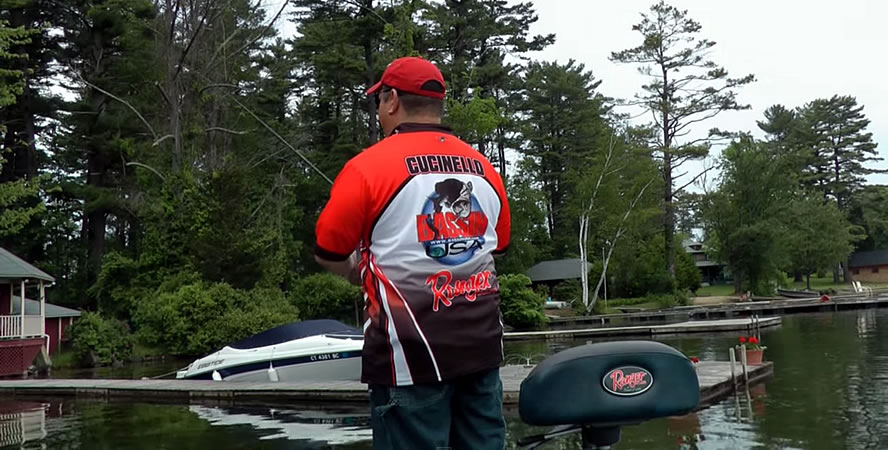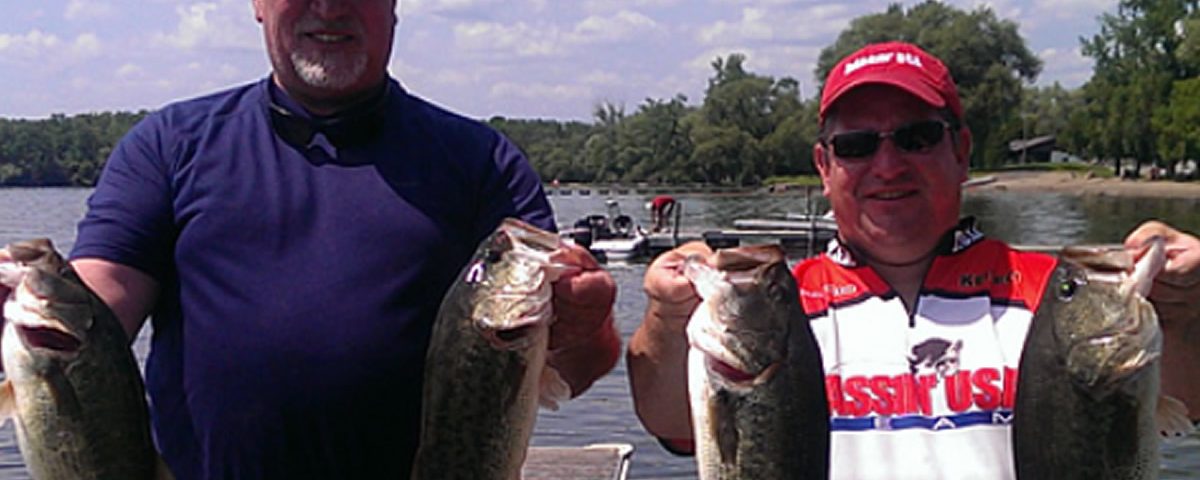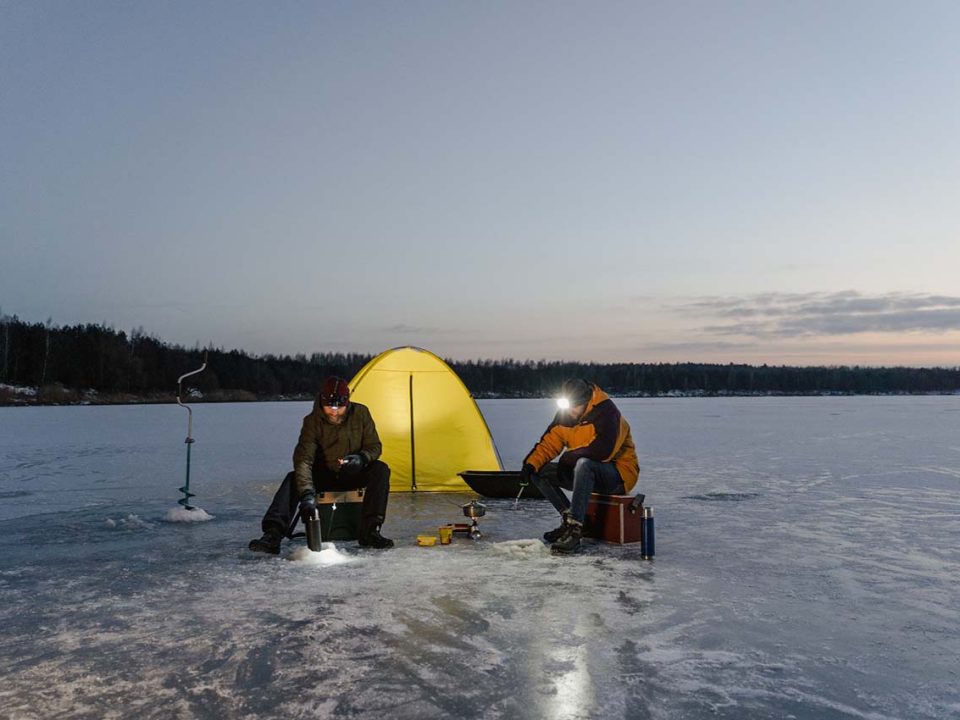
Here’s our complete guide to mastering the 6 most important techniques for targeting bass you’ll ever learn. We break down each technique with supporting tips and videos to help you learn what really makes a difference on the water.
1. Drop Shotting
The Drop Shot Rig is so unique because it allows you to suspend a soft plastic lure (or others) off the bottom at a controlled height which can range anywhere from a couple of inches to 5 feet. Why is this important? Well for starters, think about the prey that bass feed on. Most baitfish don’t just lay dead on the bottom, they suspend…unless they are truly dead. Depending on conditions they can be found close to the bottom suspended just above cover like weeds, rocks, brush piles, etc. At other times bass might be suspending out in deep open water areas waiting to ambush schools of baitfish.
The drop shot is the best one-two punches in your arsenal because you can adjust the height of your lure presentation to whatever the fish want. If they are near the bottom, you can drag, pause and even shake it subtly at times and your lure will have a “weightless” appearance when held on a semi-slack line. Here’s a couple of key tips that can make a huge difference:
TIP: Use a Palomar knot to tie on your hook and leave 2’-3’ of line on the tag end. Then you can adjust the weight until the hook is at the perfect height that results in the most bites.
TIP: When drop shotting, if you spot a bass suspended higher in the water column on your electronics, you can quickly raise the rig up to the strike zone, slowly lift and drop your rod tip until you see the bass following its movement on your graph and stop and hold it still. It’s a great way to entice a bass into striking from the water column.
Ready for some more advanced tips and tactics on Drop Shotting? Read The Complete Guide to Drop Shotting.

2. Skipping and Pitch-Skipping
There’s just something irresistible about a lure skipping across the water that triggers aggressive strikes from bass. In many cases, bass will even hit a lure while it is still skipping along the surface. If you’ve ever seen a baitfish fleeing while under attack, it’s easy to understand why the skipping action gets the attention of bass in the area. When you skip a lure, it mimics the action of something trying to escape from a predator. Bass are competitive by nature, so if you can stimulate a reaction strike with a skip cast, you can increase your cast to catch ratio dramatically.
Skipping and Pitch-Skipping are also techniques that I use to put a lure into places that cannot be reached with your typical cast. When you have the room to make a sidearm skip cast, you can get your lure way back under docks, boat houses, hanging trees, culvert pipes and other objects that are blocking access to high percentage areas. Over the years I have developed a technique that I call “Pitch-Skipping”. It combines a pitch cast and a skip cast and gives me the ability to shoot a lure without needing to make a sidearm cast. It’s deadly from a boat and even more so when you’re fishing the shoreline where trees and brush can make for some tight casting.
To learn my skip-casting technique along with a step by step guide packed with great tips for skipping, pitching and flipping, check out our video “How to skip with a baitcasting reel”.
3. Flipping and Pitching
Sometimes you need a silent approach in order to get a strike. If you notice that you are spooking bass when you are skipping a lure, it’s time to change your approach. This is where Flipping and Pitching really outshines other presentations. In the video above we also demonstrate the difference between a flip and a pitch cast. Flipping involves the use of one hand to hold the rod and the other to draw back slack line and then guide your lure into the water by controlling the speed of entry. This technique works best when you are making a lot of repeated presentations into cover and weeds that are close to you.
TIP: When flipping, twist your wrist slightly so that your reel handle is not in the way of your line.
Pitching gives you the ability to make a similar quiet presentation to targets that are further than you can reach with a flip cast. In both cases, your lure enters the water very quietly and will catch unsuspecting bass off guard. These techniques can get a reaction strikeout of the spookiest of bass under some of the toughest conditions.
Both of these techniques are an absolute must know for every bass angler.
4. Long Lining Crankbaits
Longlining is a deadly crankbait technique that allows you to get your crankbait down deeper and keep it in the strike zone for longer. There’s really nothing complicated about the technique and it will let you get down into depths of 35’ – 40’ of water. Here’s what you need:
a) Choose a deep diving crankbait that can get down around 20’ deep.
b) 7’ Crankbait Rod minimum
c) Large capacity baitcasting reel that can hold 300 yards+
d) Spool it with fluorocarbon line 8-12 lbs test (Thinner diameter means deeper quicker)
Position your boat so that you can cast past the area you want to make the most contact with. After your lure hits the water, leave the reel in free spool and use your trolling motor to drive away from the area you just cast to. Keep in mind that you want to be letting line out, not trolling your lure. Watch your line and be sure to stop before you run out of line. Stop the boat, point the bow back in the direction of your target area. Begin your normal retrieve. By doing this, you’re giving your lure more time to get down deeper. You’ll be amazed that a 20’+ diving crankbait can get down into the 35’-40’ on a 300-yard cast. Although the process may take more time than your typical chuck and wind approach, it can make some dramatic differences in the bass you’re catching. On lakes where the big ones like to live out on the really deep structure, this is another need to know tip! Check out this video on Long Lining Crankbaits by FLW Pro JT Kenney
5. Slow Rolling Swimbaits
From magnum to finesse, swimbaits flat out catch bass and big ones! When most people think about swimbaits, they think of the guys out west chucking monster swimbaits for giant California largemouth bass. Swimbaits can catch bass just about anywhere. If you’re not in the know, you are missing out on a real game changer.
Largemouth bass, smallmouth and even spotted bass chase open water baitfish. Depending on where you live and what the predominant species of baitfish determines the type of swimbait fishing you should be focusing on. In California, monster Florida strain largemouth bass grew to enormous sizes feeding on large rainbow trout which are annually stocked in many of the lakes and reservoirs on the west coast. If you’re from an area that fits this criteria, and want to seek out a trophy of a lifetime, then you might want to look into lures like the Huddleston Deluxe or some of the other larger swimbaits on the market. If you’re looking for numbers, versatility, and size you may want to try a different approach.
In the northeastern United States slow rolling a Keitech Fat 2.8”, 3.8” & 4.8” in deep water has become the tool of choice for many of the top tournament winning anglers. They come in a variety of sizes, shapes, and colors so that you can match the forage in your area. They have an action that bass just can’t resist and a unique squid scent that makes bass hold on. The technique is the same pretty much all year round and is explained in detail in our video below. Here’s what you’ll need for this technique:
Tackle Tips 3.8” & 4.8”
a) Choose a 7’ medium-heavy to heavy power bait casting rod that has some flex in the tip
b) A high-speed baitcasting reel (7.0:1 and above)
c) 12 – 17 lbs Fluorocarbon line
d) 3/8 to 3/4 Ounce football jig head
Tackle Tips 2.8”
a) Choose a 6’6” medium-light power spinning rod
b) 2500 Size Spinning Reel
c) 6 – 8 lb Fluorocarbon line
d) 1/8 to 1/4 Ounce ball jig head or football jig head
To learn this technique and to check out the Keitech swimbaits in action, watch our video “Big Winter Smallmouth”.
6. Wacky Rigging
The Wacky Rig is arguably one of the most productive methods of catching bass that was ever invented. When it comes to finesse fishing, wacky rigging a soft plastic straight tail worm or Senko is about as close as you can get to using live bait as there is. Bass can’t resist the slow fall or the action it makes when you twitch it, pull it and then let it float slowly back down towards the bottom. It can be fished around all types of cover including weeds, rocks, trees, docks, you name it. It can be used with braided line or any other type line you like. Don’t be fooled by this technique, it doesn’t just catch bass, it catches big bass. It is the perfect combination for skipping on spinning gear too. Here are the basics of what you need:
Tackle Tips
a) Choose a 6’6” medium power, fast action spinning rod
b) 2500 Size Spinning Reel
c) 6 – 8 lb Diameter Line of choice, however, braided line can help you get those big ones out of heavy cover
d) Extra Wide Gap (EWG) or Octopus style hook. 2/0 – 5/0 depending on the size of the Senko or worm.
For more on the Wacky Rig, check out our Guide to Wacky Worming by Prostaff member Dan McGarry





